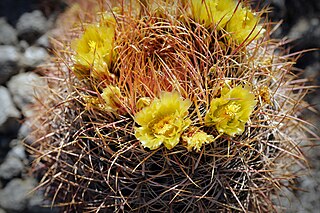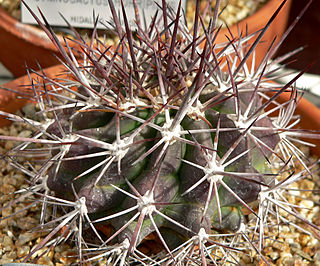
Echinocereus engelmannii, the strawberry hedgehog cactus or Engelmann's hedgehog cactus, is a cactus commonly found in desert areas of the southwestern United States and the adjacent areas of Mexico, including the states of California, Nevada, Utah, Arizona, Baja California and Sonora.

Ferocactus cylindraceus is a species of barrel cactus which is known by several common names, including California barrel cactus, Desert barrel cactus, compass barrel cactus, and miner's compass. It was first described by George Engelmann in 1853.

Ferocactus glaucescens, the glaucous barrel cactus, is a species of flowering plant in the family Cactaceae, native endemic to México.

Ferocactus echidne is a barrel cactus in the genus Ferocactus. It is found in nature in Mexico. This cactus is known commonly as Sonora barrel, Coville's barrel cactus, Emory's barrel cactus, and traveler's friend. This plant is often sold as a houseplant.

Ferocactus peninsulae is a barrel cactus in the genus Ferocactus of the family Cactaceae.

Echinocereus berlandieri is a species of hedgehog cactus. Its range includes most of South Texas, and is commonly found along the Nueces River and the lower Rio Grande.

Cochemiea conoidea, common name Texas cone cactus or Chihuahuan beehive, is a species of cactus native to southern United States to central Mexico.

Ferocactus gracilis, the fire barrel cactus, is a species of Ferocactus from Northwestern Mexico. This cactus gets its common name from the striking red coloration of its defensive spines and flowers.

Echinocereus bonkerae, also known as pinkflower hedgehog cactus, Bonker hedgehog, or short spined strawberry cactus, is a species of hedgehog cactus.

Ferocactus lindsayi is a species of Ferocactus found in Mexico.

Ferocactus johnstonianus is a species of Ferocactus found in Mexico

Cochemiea poselgeri is a species of Cochemiea found in Mexico
Cochemiea pondii is a species of Cochemiea found in Mexico.

Echinocereus viereckii is a species of cactus native to Mexico.

Echinocereus brandegeei is a species of cactus native to Mexico.

Echinocereus ferreirianus is a species of cactus native to Mexico.

Echinocereus maritimus is a species of cactus native to Mexico.

Echinocereus sciurus is a species of cactus native to Mexico.

Echinocereus adustus is a species of cactus native to Mexico.

Echinocereus laui is a species of cactus native to Mexico.





















